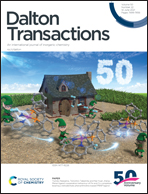Persistent room-temperature phosphorescence or high-contrast phosphorescent mechanochromism: polymorphism-dependent different emission characteristics from a single gold(i) complex†
Abstract
Luminophores with persistent room-temperature phosphorescence (p-RTP) or effective phosphorescent mechanochromism features have significant potential applications in the field of optoelectronic materials. Until now, p-RTP and remarkable phosphorescent mechanochromism phenomena have been observed in some luminescent molecules with different molecular structures. However, separately realizing p-RTP and high-contrast phosphorescent mechanochromism in different polymorphs from a single luminophore is still a valuable and challenging topic. In this work, two polymorphs 1B and 1YG of a new gold(I) complex with blue and yellow-green luminescence, respectively, are reported. Interestingly, 1B exhibits high-contrast phosphorescent mechanochromic behavior, while 1YG exhibits a persistent room-temperature phosphorescence effect. This is the first example of simultaneously obtaining double-purpose crystalline materials with a high-contrast phosphorescent mechanochromism or persistent room-temperature phosphorescence feature from a single luminophore.



 Please wait while we load your content...
Please wait while we load your content...